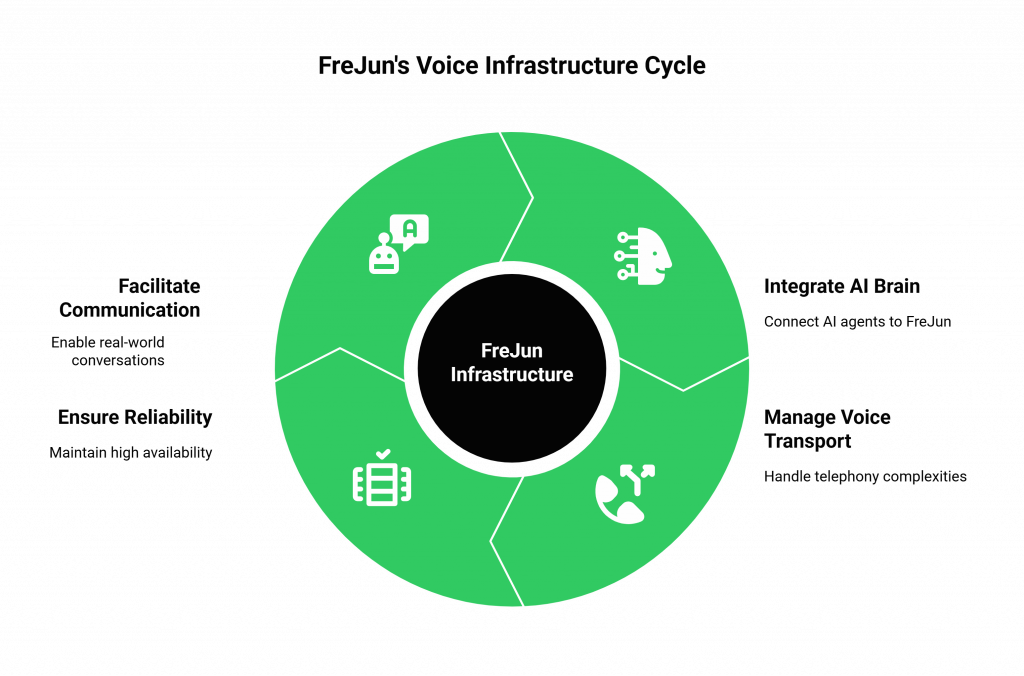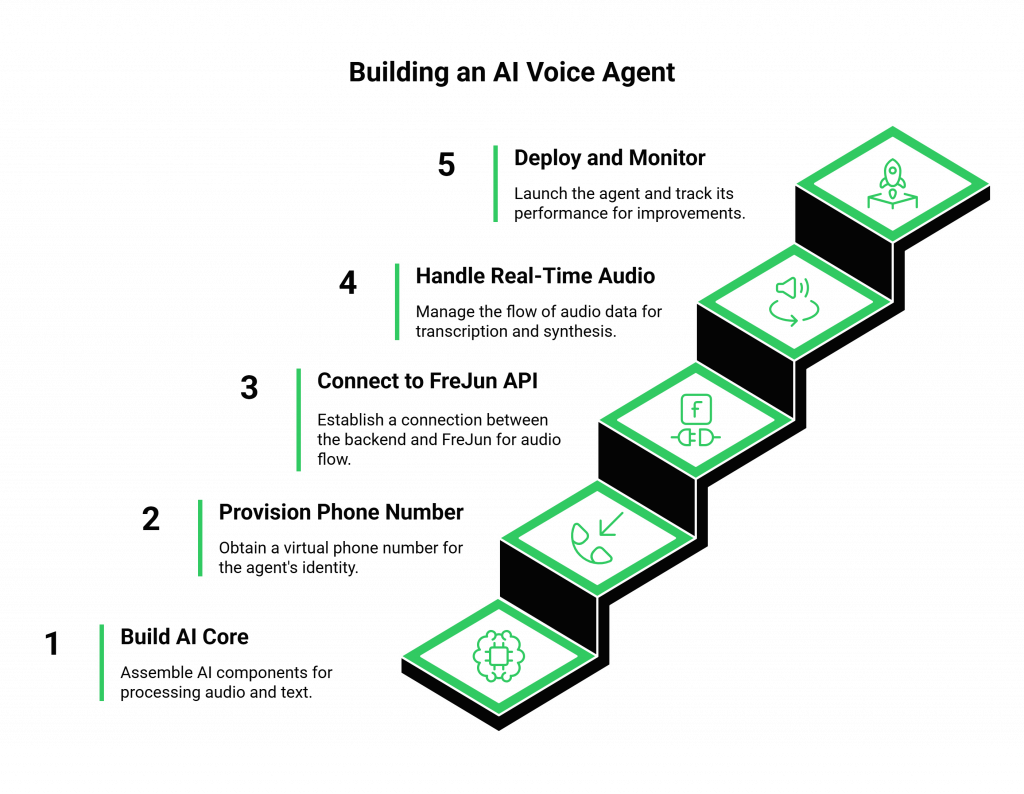The world of conversational AI is advancing at a blistering pace, and at the heart of this revolution are powerful Large Language Models (LLMs) like DeepSeek-V3. This model, with its Mixture-of-Experts (MoE) architecture and agentic capabilities, provides developers with a formidable “brain” for building sophisticated, context-aware assistants. The path to creating AI voice agents using DeepSeek-V3 seems clearer than ever.
Table of contents
- What are AI Voice Agents Using DeepSeek-V3?
- The Hidden Challenge: A Brilliant AI Without a Voice
- FreJun: The Voice Infrastructure Layer for Your DeepSeek-V3 Agent
- DIY Telephony vs. A FreJun-Powered Agent: A Comparison
- Step-by-Step Guide: How to Build a Complete AI Voice Agent
- Best Practices for a Flawless Implementation
- Final Thoughts
- Frequently Asked Questions (FAQ)
You can design a brilliant agent, connect it to your business systems, and watch it generate remarkably intelligent and helpful responses. However, a critical and often underestimated challenge remains that prevents these creations from reaching their full potential. An AI brain, no matter how powerful, is useless for many business-critical applications if it cannot connect to the real world through the most ubiquitous communication channel of all: the telephone.
What are AI Voice Agents Using DeepSeek-V3?
An AI voice agent is a system that can listen, understand, and respond conversationally. Building AI voice agents using DeepSeek-V3 offers a distinct advantage for enterprise applications. It’s a model designed not just for casual chat, but for serious, high-stakes conversational workflows. Key features include:
- Mixture-of-Experts (MoE) Architecture: DeepSeek-V3 is a powerful MoE LLM with 671 billion total parameters and 37 billion activated per token, designed for scalable, real-time conversational AI applications.
- Agentic Capabilities: The model supports agentic capabilities with multi-step reasoning, tool use, and can be integrated with ASR and TTS systems for building responsive AI voice agents.
- OpenAI-Compatible API: The API is OpenAI-compatible, enabling easy adoption with existing AI toolchains and SDKs.
The Hidden Challenge: A Brilliant AI Without a Voice
You have designed a brilliant agent. It’s powered by DeepSeek-V3, it’s connected to your business systems via your backend, and it’s ready to revolutionize your customer experience. Now, you need it to answer a phone call. This is where most projects hit a formidable wall.
The entire ecosystem of AI tools is designed to provide the “brain” for your agent. They are text-in, text-out systems. They do not provide the underlying infrastructure needed to connect that brain to the Public Switched Telephone Network (PSTN). To make your agent answer a phone call, you would have to build a highly specialized and complex voice infrastructure stack from the ground up. This involves solving a host of non-trivial engineering problems:
- Telephony Protocols: Managing SIP (Session Initiation Protocol) trunks and carrier relationships.
- Real-Time Media Servers: Building and maintaining dedicated servers to handle raw audio streams from thousands of concurrent calls.
- Call Control and State Management: Architecting a system to manage the entire lifecycle of every call, from ringing and connecting to holding and terminating.
- Network Resilience: Engineering solutions to mitigate the jitter, packet loss, and latency inherent in voice networks that can destroy the quality of a real-time conversation.
This is the hidden challenge. Your team, expert in AI and application development, is suddenly forced to become telecom engineers. The project stalls, and the brilliant agent you built remains trapped, unable to be reached by the millions of customers who rely on the telephone.
FreJun: The Voice Infrastructure Layer for Your DeepSeek-V3 Agent
This is the exact problem FreJun was built to solve. We are not another AI platform. We are the specialized voice infrastructure layer that connects the powerful AI voice agents using DeepSeek-V3 to the global telephone network.

FreJun Teler provide a simple, developer-first API that handles all the complexities of telephony, so you can focus on building the best AI possible.
- We are AI-Agnostic: You bring your own “brain.” FreJun integrates seamlessly with any backend, allowing you to connect directly to the DeepSeek-V3 API.
- We Manage the Voice Transport: We handle the phone numbers, the SIP trunks, the media servers, and the low-latency audio streaming.
- We Guarantee Reliability and Scale: Our globally distributed, enterprise-grade infrastructure ensures your phone line is always online and ready to handle high call volumes.
FreJun provides the robust “body” that allows your AI “brain” to have a real, meaningful conversation with the outside world via the telephone.
DIY Telephony vs. A FreJun-Powered Agent: A Comparison
| Feature | The Full DIY Approach (Including Telephony) | Your DeepSeek-V3 Backend + FreJun |
| Infrastructure Management | You build, maintain, and scale your own voice servers, SIP trunks, and network protocols. | Fully managed. FreJun handles all telephony, streaming, and server infrastructure. |
| Scalability | Extremely difficult and costly to build a globally distributed, high-concurrency system. | Built-in. Our platform elastically scales to handle any number of concurrent calls on demand. |
| Development Time | Months, or even years, to build a stable, production-ready telephony system. | Weeks. Launch your globally scalable voice bot in a fraction of the time. |
| Developer Focus | Divided 50/50 between building the AI and wrestling with low-level network engineering. | 100% focused on building the best possible conversational experience. |
| Maintenance & Cost | Massive capital expenditure and ongoing operational costs for servers, bandwidth, and a specialized DevOps team. | Predictable, usage-based pricing with no upfront capital expenditure and zero infrastructure maintenance. |
Step-by-Step Guide: How to Build a Complete AI Voice Agent
This step-by-step guide outlines the modern, efficient process for deploying AI voice agents using DeepSeek-V3 that can handle real phone calls.

Step 1: Build Your AI Core (The “Brain”)
First, assemble your AI stack.
- Set up your DeepSeek-V3 Model: Get access to the DeepSeek-V3 API and configure your client to use the DeepSeek-V3 model.
- Integrate ASR and TTS: Choose your preferred speech recognition engine (like tiny, small, or medium) and text-to-speech engine (like ElevenLabs for speech synthesis).
- Orchestrate with a Backend: Write a backend application (e.g., in Python using AssemblyAI for real-time streaming transcription, Ollama to interact with the DeepSeek-V3 model, and ElevenLabs for TTS audio output) that orchestrates these components. It should be able to take an audio input, transcribe it, send the text to DeepSeek-V3, get a response, and synthesize it back into audio.
Step 2: Provision a Phone Number with FreJun
Instead of negotiating with telecom carriers, simply sign up for FreJun and instantly provision a virtual phone number. This number will be the public-facing identity for your AI agent.
Step 3: Connect Your Backend to the FreJun API
In the FreJun dashboard, configure your new number’s webhook to point to your backend’s API endpoint. This tells our platform where to send live call audio and events. Our server-side SDKs make handling this connection simple.
Step 4: Handle the Real-Time Audio Flow
When a customer dials your FreJun number, our platform answers the call and establishes a real-time audio stream to your backend. Your code will then:
- Receive the raw audio stream from FreJun.
- Pipe this audio to your ASR engine to be transcribed.
- Send the transcribed text to your DeepSeek-V3 model for processing, including the relevant chat history to maintain context.
- Take the AI’s text response and send it to your TTS engine for synthesis.
- Stream the synthesized audio back to the FreJun API, which plays it to the caller with ultra-low latency.
Step 5: Deploy and Monitor Your Solution
Deploy your backend application to a scalable cloud provider. Once live, use monitoring tools to track your bot’s performance, analyze user interactions, and continuously improve its accuracy and effectiveness.
Best Practices for a Flawless Implementation
- Maintain Conversational Context: Leverage DeepSeek-V3’s knowledge integration to handle domain-specific queries and personalized responses.
- Use RAG for Accuracy: For domain-specific applications, integrate a Retrieval-Augmented Generation (RAG) system. This connects your DeepSeek-V3 model to your own knowledge base, ensuring your bot provides factual, accurate responses.
- Design for Human Handoff: No AI is perfect. For complex issues, design a clear path to escalate the conversation to a human agent. FreJun’s API can facilitate a seamless live call transfer.
- Secure Your API Keys: When you build AI voice agents using DeepSeek-V3, your DeepSeek-V3 API key is a sensitive credential. Never expose it in client-side code. Always manage it securely on your backend using environment variables or a secret manager.
Final Thoughts
The freedom to build with powerful models like DeepSeek-V3 is a revolutionary advantage. It allows you to create a truly unique and differentiated conversational AI experience. But that advantage is lost if your team gets bogged down in the complex, undifferentiated heavy lifting of building and maintaining a global voice infrastructure.
The strategic path forward is to focus your resources where they can create the most value: in the intelligence of your AI, the quality of your conversation design, and the seamless integration with your business logic. Let a specialized platform handle the phone lines.
By partnering with FreJun, you can maintain the full freedom of a custom AI stack while leveraging the reliability, scalability, and speed of an enterprise-grade voice network. You get to build the bot of your dreams, and we make sure it can answer the call.
Further Reading – Step-by-Step Guide to Voice Chat Bot Integration
Frequently Asked Questions (FAQ)
No. FreJun is a model-agnostic voice infrastructure platform. We provide the essential API that connects your application to the telephone network. This is the core of our philosophy, you have the complete freedom to build your own ai voice agents with any components you choose.
This is managed by your backend. When DeepSeek-V3 determines that it needs to use a tool, it will send a request to your backend. Your backend code will then execute the tool (e.g., make a database query), send the result back to DeepSeek-V3, and then the model will use that result to formulate its final response.
No. We abstract away all the complexity of telephony. If you can work with a standard backend API and a WebSocket, you have all the skills needed to build powerful AI voice agents using DeepSeek-V3.
Yes. FreJun’s API provides full, programmatic control over the call lifecycle, including the ability to initiate outbound calls. This allows you to use your custom-built bot for proactive use cases like automated reminders or lead qualification campaigns.
